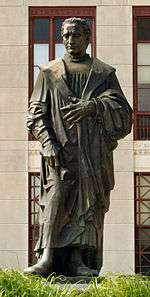Columbus City Hall (Columbus, Ohio)
| Columbus City Hall | |
|---|---|
 The east facade of Columbus City Hall in 2005 | |
| General information | |
| Architectural style | Neoclassical Revival |
| Address |
90 West Broad Street Columbus, Ohio 43215 |
| Country | United States |
| Coordinates | 39°57′46″N 83°00′12″W / 39.962783°N 83.003328°WCoordinates: 39°57′46″N 83°00′12″W / 39.962783°N 83.003328°W |
| Groundbreaking | October 1926 |
| Inaugurated | April 1928 |
| Renovated | 1936, 1949 |
Columbus City Hall is the city hall of Columbus, Ohio, located at 90 West Broad Street, at the intersection of Broad and Front Streets, in the city's Civic Center on the east bank of the Scioto River. Among others, it contains the offices of the city's Mayor, Auditor, and Treasurer, and the offices and chambers of Columbus City Council. It was built during a period of extensive construction along the city's riverfront, including the building of the American Insurance Union Citadel, now known as the LeVeque Tower, directly to the east across Front Street.
In 1921, a fire destroyed the old City Hall, built in 1872 at East State and Third Streets,[1][2] now the site of the Ohio Theatre.[3] James John Thomas, mayor of Columbus from 1920 to 1931, laid the cornerstone for a new City Hall on October 29, 1926.[4] The building was dedicated on April 18, 1928. The five-story building, constructed of Indiana limestone, was designed by the Allied Architects Association of Columbus in the Neoclassical Revival style and built at a cost of US$1.7 million,[5] equivalent to $23.47 million in 2015.[6] Allied Architects also designed the adjacent Central Police Station building at West Gay Street and Marconi Boulevard, which opened on March 26, 1930, was abandoned in 1991 with the opening of a new police headquarters building, and was renovated in 2012 to allow the consolidation of various city government offices.[7][8] City Hall was originally also the venue for the city's Municipal Court, and its proximity to the Police Station building provided for efficient movement of prisoners between the two buildings.

Initially built in three sections surrounding a central courtyard, a fourth section was added on the west side of City Hall in 1936 to enclose the courtyard and provide additional office space. The structure was further renovated in 1949.[5]
City Council chambers, located on the second floor, were fully restored in 1986, and feature Art Deco elements echoing those found throughout the building.[5]
The south patio of City Hall facing Broad Street was named the M. D. Portman Plaza in 1996 after a long-serving City Council member,[9] and is home to a 20 foot (6.1 m) tall bronze statue of Christopher Columbus by Italian sculptor Edoardo Alfieri.[10] The statue was a gift to the city of Columbus from the citizens of Genoa, Italy and was dedicated on October 12, 1955.[5]
References
- ↑ Egger, Charles, ed. (1975). Columbus Mayors (PDF). Columbus Citizen-Journal. Columbus, Ohio. p. 44.
- ↑ Lentz, Ed (2003). Columbus: The Story of a City. Arcadia Publishing. p. 111. ISBN 9780738524290.
- ↑ Perkins, Michael A. (Dec 17, 2004). Leveque: The First Complete Story of Columbus' Greatest Skyscraper. Author House. p. 10. ISBN 9781468518962.
- ↑ "Columbus City Hall cornerstone dedication (1926 photo)". OhioMemory.org. December 5, 2015. Retrieved 23 March 2016.
- 1 2 3 4 "Scioto Riverfront History: City Hall". sciotogreenways.com. Retrieved 23 March 2016.
- ↑ http://www.usinflationcalculator.com/inflation/consumer-price-index-and-annual-percent-changes-from-1913-to-2008/
- ↑ "Central Police Station (1945 photo)". Columbus Metropolitan Library Digital Collection. Retrieved 23 March 2016.
- ↑ Lydia Coutré (August 14, 2012). "Columbus wants to consolidate city offices". Columbus Dispatch. Retrieved 23 March 2016.
- ↑ Carmen, Barbara (May 21, 1996). "Columbus City Council names the south patio of City Hall 'M D Portman Plaza' at Portman's last official Council meeting". Columbus Dispatch. p. 2 C.
- ↑ http://www.dispatch.com/content/blogs/a-look-back/2011/10/uncrating-christopher-columbus-1955.html
Further reading
- Barrett, Richard E. (2005). Columbus 1860-1910. Arcadia Publishing. p. 29. ISBN 9780738539621.
- Darbee, Jeffrey T.; Recchie, Nancy A. (2008). The AIA Guide to Columbus. Ohio University Press. p. 73. ISBN 9780821416846.
- Barrett, Richard E. (2002). Columbus, Ohio: 1898-1950 in Vintage Postcards. Arcadia Publishing. p. 19. ISBN 9780738519623.
- "Don't Burn Up Your Public Records". The American City. 24 (6): 577. June 1921.
- "Columbus to Have Civic Center". The Modern City. 6 (4): 11. April 1921.
External links
| Wikimedia Commons has media related to Columbus City Hall (Columbus, Ohio). |